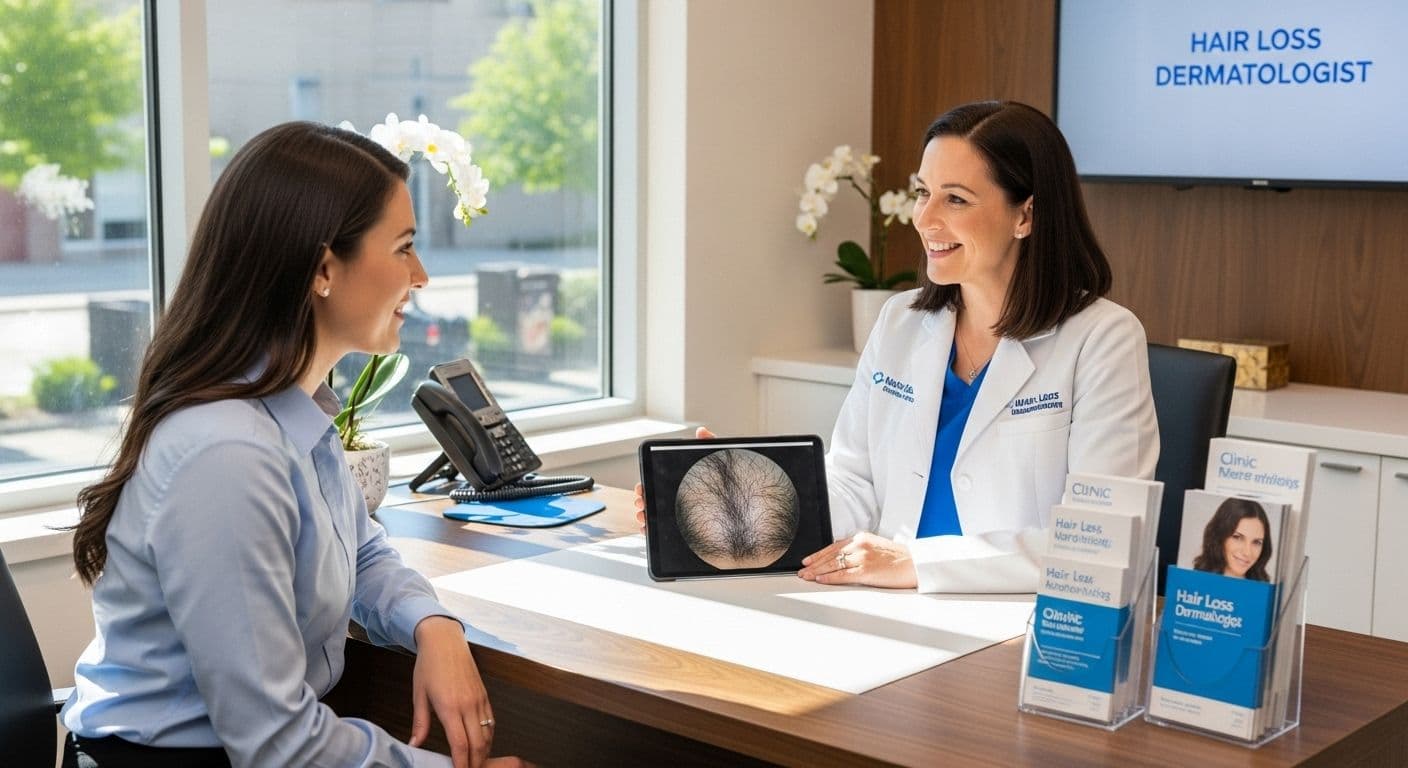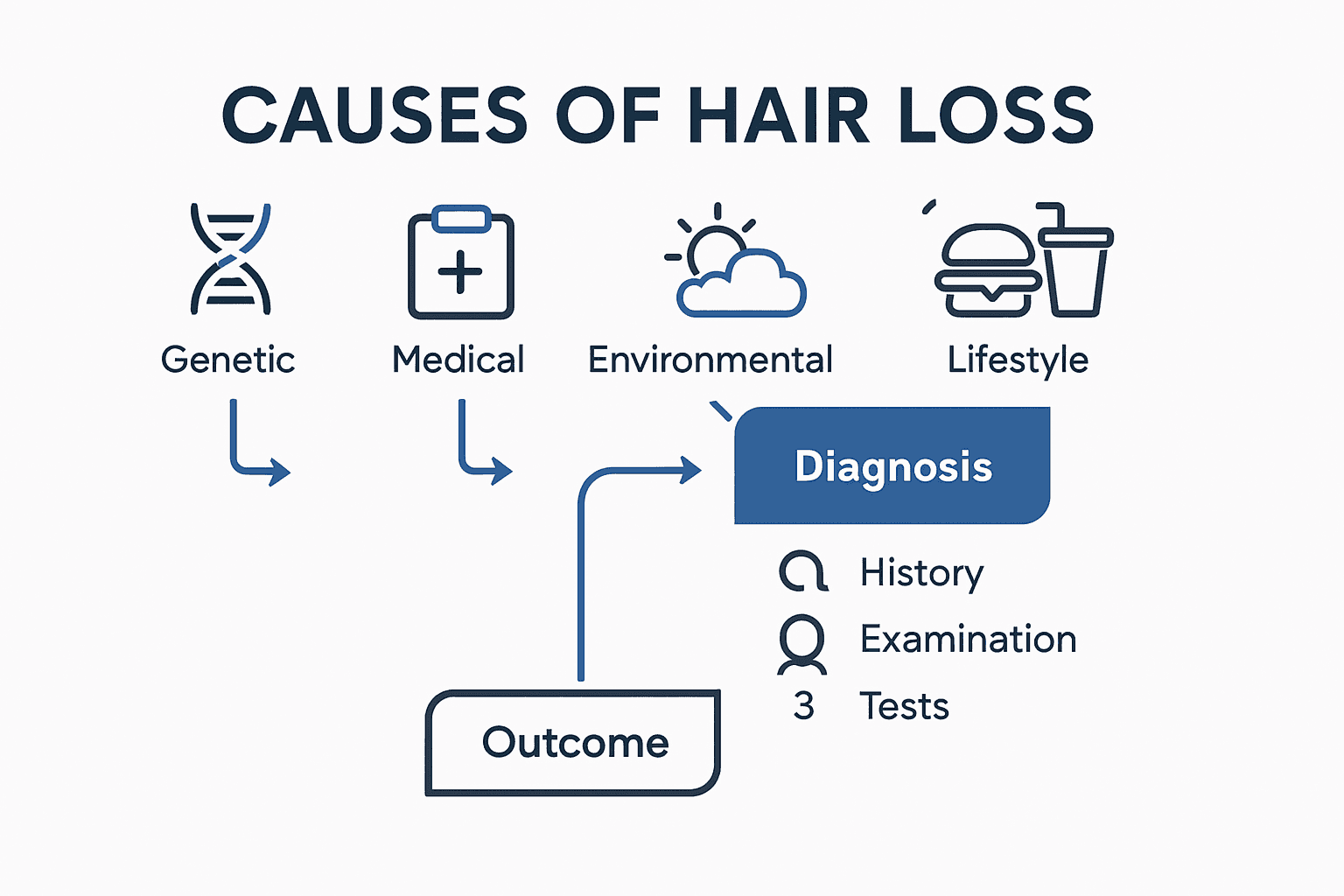Blog
Learning Materials
Hair Loss Dermatologist Guide: Solutions for 2025
Updated: August 5, 2025

Millions of Americans battle hair loss every year and the search for lasting solutions can feel frustrating. Shockingly, over 90 percent of scalp hair is usually growing at any moment yet many still notice sudden patches of thinning or hair falling out by the handful. Most assume there is little to be done beyond expensive shampoos or old-school remedies but rapid breakthroughs in high-tech treatments are flipping that story on its head. The next wave of dermatology-led solutions for 2025 is rewriting what hair regrowth really looks like.
Table of Contents
- When To See A Hair Loss Dermatologist
- Common Causes And Diagnosis Of Hair Loss
- Top Hair Loss Treatments And Innovations
- Tips For Tracking Hair Growth Progress
Quick Summary
| Takeaway | Explanation |
|---|---|
| See a dermatologist for sudden hair loss | Rapid or unexpected hair shedding may indicate health issues requiring professional evaluation. |
| Understand genetic and physiological factors | Factors like family history and age can significantly affect hair loss patterns. |
| Utilize emerging hair loss treatments | New technologies such as stem cell therapy and advanced medications offer promising solutions. |
| Track hair growth progress systematically | Effective monitoring through photos and measurements helps assess treatment effectiveness. |
| Document health changes affecting hair | Keeping a treatment journal can identify factors influencing your hair restoration journey. |
When to See a Hair Loss Dermatologist
Identifying the right moment to consult a hair loss dermatologist can be crucial in addressing potential underlying health issues and preventing further hair loss. Hair loss is not just a cosmetic concern but often signals important health signals that require professional medical attention.
Signs Indicating Professional Consultation
Understanding when to seek professional help is essential for effective hair loss management. Learn about typical hair shedding patterns to distinguish between normal hair fall and concerning hair loss.
Some critical signs that warrant immediate dermatological consultation include:
- Sudden Hair Loss: Experiencing rapid or unexpected hair shedding, where you notice significant hair thinning or bald patches
- Scalp Changes: Developing unusual scalp conditions like scaling, redness, or persistent itching
- Pattern Baldness: Observing systematic hair thinning following specific genetic patterns
According to the University of Vermont Health Network, you should see a doctor if you notice sudden hair loss, experience hair shedding in large amounts after combing or brushing, or if your hair becomes noticeably thinner.
Medical Conditions and Medication Impacts
Hair loss can stem from various medical conditions and medication side effects. The University of Utah Health emphasizes that dermatologists specialize in diagnosing and treating hair loss causes, particularly when related to underlying health issues.
Potential triggers for seeking professional evaluation include:
- Thyroid disorders
- Autoimmune conditions
- Hormonal imbalances
- Potential medication side effects
- Nutritional deficiencies
A professional dermatologist can conduct comprehensive assessments, including blood tests and scalp examinations, to determine the root cause of your hair loss. They will develop personalized treatment strategies that address both symptomatic and underlying health concerns.
Remember that early intervention can significantly improve treatment outcomes and potentially prevent permanent hair loss. Professional dermatological consultation provides not just treatment but a holistic understanding of your individual hair health scenario.
Common Causes and Diagnosis of Hair Loss
Understanding the complex landscape of hair loss requires a comprehensive approach to identifying its root causes and implementing accurate diagnostic procedures. Hair loss is rarely a simple or singular issue, often involving multiple interconnected factors that demand professional medical evaluation.
Genetic and Physiological Factors
According to Johns Hopkins Medicine, approximately 90% of scalp hair grows continuously, with each hair experiencing a growth phase lasting 2 to 6 years. Genetic predispositions play a significant role in hair loss, with conditions like androgenetic alopecia being primarily inherited.
Explore normal hair shedding patterns to understand the difference between typical hair loss and more serious conditions. Key genetic and physiological contributors include:
- Family history of baldness
- Hormonal changes
- Age-related hair thinning
- Autoimmune disorders
- Thyroid conditions
Medical and Environmental Triggers

The Mayo Clinic highlights several risk factors that can accelerate or cause hair loss. These include significant weight loss, chronic medical conditions, stress, and nutritional deficiencies. The American Academy of Dermatology Association further elaborates on additional potential causes:
- Nutritional deficiencies (iron, protein, biotin, zinc)
- Sexually transmitted infections
- Thyroid disease
- Exposure to certain environmental toxins
- Friction from tight clothing or hairstyles
Diagnostic processes typically involve comprehensive medical assessments, including detailed medical history, physical examinations, blood tests, and potentially scalp biopsies. Dermatologists aim to pinpoint the specific underlying cause to develop targeted treatment strategies.
While many hair loss conditions can be successfully treated, the key lies in early detection and understanding the unique factors contributing to an individual's hair loss. Professional medical evaluation remains the most effective approach to developing a personalized hair restoration plan.
To help readers quickly identify and compare the main causes and triggers of hair loss, the following table summarizes genetic, medical, and environmental factors mentioned above:
| Cause Category | Example Triggers | Description/Notes |
|---|---|---|
| Genetic & Physiological | Family history, hormonal changes, aging, autoimmune, thyroid | Inherited or bodily factors altering hair growth |
| Medical Conditions | Thyroid disease, autoimmune conditions, STIs | Disorders directly impacting hair follicles |
| Medication & Deficiencies | Medications, iron/protein/biotin/zinc deficiency | Side effects or lack of key nutrients |
| Environmental Factors | Environmental toxins, friction from hair styling | External factors causing or accelerating loss |
| Stress & Drastic Changes | Stress, significant weight loss | Sudden changes that disrupt hair cycle |
Top Hair Loss Treatments and Innovations
The landscape of hair loss treatment is rapidly evolving, with breakthrough technologies and innovative approaches offering renewed hope for individuals experiencing hair thinning and baldness. As scientific understanding deepens, more personalized and effective solutions are emerging that address the complex mechanisms behind hair loss.
Pharmacological and Medical Interventions
Traditional medical treatments continue to play a crucial role in hair restoration. Learn about targeted treatments for specific hair loss patterns to understand the range of pharmaceutical options available.
Current pharmacological approaches include:
- Topical Medications: Minoxidil and other prescription topical treatments that stimulate hair follicle activity
- Oral Medications: Finasteride and similar drugs that block hormonal processes contributing to hair loss
- Prescription Therapies: Corticosteroids for autoimmune-related hair loss conditions
Cutting-Edge Technological Innovations
Recent scientific breakthroughs are revolutionizing hair loss treatment. The University of Wisconsin-Madison developed a groundbreaking wearable electric stimulation device that promotes hair regrowth through low-frequency electric pulses.
Additionally, Harvard researchers have created innovative microneedle patches that deliver targeted T cell regulators directly to affected scalp areas, showing remarkable potential in treating autoimmune-related hair loss.
Emerging Advanced Treatment Strategies
Researchers at the University of Virginia have identified previously overlooked stem cell populations in hair follicles, suggesting potential for revolutionary regenerative approaches. This discovery opens new pathways for understanding and potentially reversing hair loss mechanisms.
Advanced treatment strategies now include:
- Stem cell therapies
- Platelet-rich plasma (PRP) treatments
- Precision genetic interventions
- Advanced scalp micropigmentation techniques
The future of hair loss treatment is increasingly personalized, combining medical expertise, technological innovation, and individual genetic profiling. While no universal solution exists, the rapid pace of scientific advancement promises more effective and targeted interventions for individuals experiencing hair loss.
To clarify current treatment options, technologies, and new approaches, the table below compares traditional treatments, cutting-edge innovations, and emerging strategies as outlined in the content:
| Treatment Type | Examples | Main Purpose/Usage |
|---|---|---|
| Topical Medications | Minoxidil, prescription topicals | Stimulate hair follicle activity |
| Oral Medications | Finasteride, similar drugs | Block hormonal causes of hair loss |
| Prescription Therapies | Corticosteroids (for autoimmune causes) | Treat autoimmune-related hair loss |
| Wearable Device Innovations | Electric stimulation device (Univ. Wisconsin) | Promote regrowth through scalp stimulation |
| Microneedle Patch Therapy | T cell regulator delivery (Harvard) | Targeted autoimmune hair loss treatment |
| Advanced Regenerative Strategies | Stem cell therapy, PRP, genetic interventions | Regrow or restore hair by addressing underlying biological factors |
| Cosmetic/Procedural Options | Scalp micropigmentation | Improve appearance of thinning or bald areas |
Tips for Tracking Hair Growth Progress
Tracking hair growth progress is a critical component of understanding and managing hair loss treatment effectiveness. Systematic monitoring allows individuals to assess treatment responses, make informed decisions, and collaborate effectively with healthcare professionals.
Scientific Measurement Techniques
Explore advanced hair loss tracking methods to understand the most precise approaches to monitoring hair growth. Scientific measurement techniques provide objective insights into hair restoration progress.
According to the Journal of Clinical and Aesthetic Dermatology, reliable tracking methods include:
- Standardized Photography: Taking consistent, high-resolution scalp photographs under identical lighting and positioning
- Hair Density Measurements: Quantitative analysis of hair count and thickness in specific scalp regions
- Digital Imaging Tools: Advanced software for precise hair follicle tracking and comparative analysis
Digital and Personal Tracking Strategies
The International Journal of Trichology highlights phototrichograms as an effective technique for monitoring hair growth. Modern technological approaches offer comprehensive tracking options:
- Regular digital scalp scans
- Detailed hair count logs
- Smartphone application tracking
- Professional dermatologist assessments
- Periodic professional microscopic evaluations
Comprehensive Progress Documentation
Research from the Journal of Investigative Dermatology emphasizes the importance of consistent, objective hair growth documentation. Effective tracking involves more than just visual assessment and requires a multifaceted approach:
- Maintain a detailed treatment journal
- Record monthly photographs from multiple angles
- Track concurrent health and lifestyle factors
- Document medication and treatment timelines
- Note environmental and nutritional changes

Successful hair growth tracking requires patience, consistency, and a holistic approach. By combining scientific measurement techniques with personal documentation, individuals can gain valuable insights into their hair restoration journey and make data-driven decisions about their treatment strategies.
Frequently Asked Questions
When should I see a dermatologist for hair loss?
Consult a dermatologist if you experience sudden hair loss, noticeable thinning after brushing or combing, or any unusual changes to your scalp such as scaling, redness, or persistent itching.
What are the common causes of hair loss?
Common causes include genetic factors like family history of baldness, hormonal changes, autoimmune disorders, thyroid conditions, nutritional deficiencies, and environmental triggers.
What treatment options are available for hair loss?
Treatment options include topical medications like minoxidil, oral medications such as finasteride, corticosteroids for autoimmune-related hair loss, and emerging therapies like stem cell treatments and platelet-rich plasma (PRP) treatments.
How can I track my hair growth progress effectively?
To track hair growth progress, use standardized photography for consistent visual documentation, measure hair density in specific areas, and maintain a treatment journal to record health changes, treatments, and results.
Ready to Take Control of Your Hair Loss Journey?
You have just read about the importance of early intervention, personalized analysis, and systematic tracking when searching for effective hair loss solutions. It can feel discouraging to face sudden thinning or struggle with unclear progress, especially when traditional remedies do not give you answers or results. The article highlighted the power of professional strategies and advanced tracking methods, exactly what MyHair.ai delivers.

Stop guessing and start knowing. Upload your own scalp scans and get instant AI-driven assessments tailored to your unique hair patterns. Track changes, identify what works, and receive specific product recommendations designed for your hair type. Visit MyHair.ai right now and discover the difference personalized technology makes. Begin your journey to confident, data-backed hair restoration today.